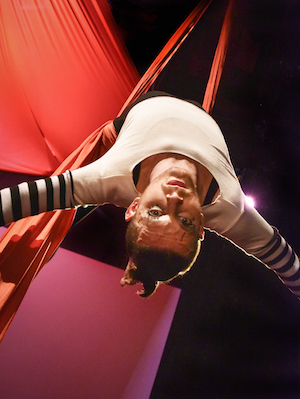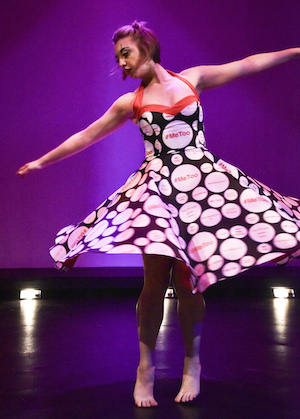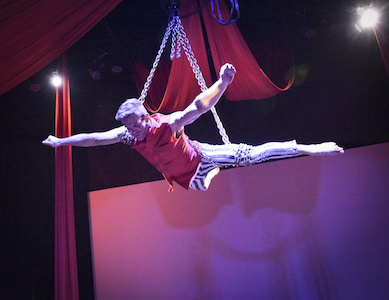Never Again
Never Again
Reminding us of history so that we need not repeat it

Photography by Cory Cannella. Davis Stumberg pictured.
The work of choreographer Toni Leago Valle has often dealt with political subjects, particularly issues faced by women. Motherhood in I am Goddess and female body image in Cracked, for example. So when I say with Never Again Valle may have produced her most pointed work yet, that’s saying something.
Valle lets us know, in a pre-curtain announcement, that Never Again is not concert dance, but vaudeville. This is immediately reinforced with the appearance of a master of ceremonies wearing clown makeup and red gloves. Throughout the show there are repeated references to circuses. The opening number is set to calliope music, albeit overlaid with a reading of the “fetal remains” and “bathroom” bills. Performances on the aerial silks too are reminiscent of Barnum and Bailey (although never dressed like this!)
The starkest references, however, are those of Weimar and early Hitler-era Germany. Dancers march in heavy black boots. The suspenders over chests bare but for sequin pasties are reminiscent of Alan Cumming in Broadway’s revival of Cabaret. Shorts and stockings with garter belts, particularly when paired with a dance performed facing backward on a chair, summons the ghost of Liza Minelli and the Kit Kat girls.
Many of Valle’s images are both historical and subversive. Several of the dancers’ gestures, as well as the “cat suits” of one duet, remind one of both the Kit Kat Club and pussy hats. The Gestapo great coat worn by one dancer is covered in swastikas X’d out in red. Dresses are made of custom fabric exhorting one to “resist!” or “#METOO”. Butcher’s aprons sport a silk screened coat hanger and the words “never again.” Valle’s vision was well served by the work of costume designer Judy Masliyah, whose original fabric design messages deliberately add both political content and a disturbing contrast to traditional silhouettes.
Indeed, “disturbing contrast” might well be considered another artistic theme of Never Again. Opening Never Again is the afore-mentioned calliope music with dancers in over the knee stockings and boots. Undulating arms recall Bob Fosse (choreographer of Cabaret). This was followed by a dance of puppet or doll-like movements performed to a voice over “Why I want a Wife,” the 1970 classic feminist essay.

Photography by Cory Cannella. Kate Rash pictured.
Boots made a return appearance in the next piece, with military parade elements disrupted by raised middle fingers. “Shouting” gestures accompanied the following piece, whose “no means no” contrasted with the “What were you wearing?” “Were you drinking?” responses which often greet a rape victim.
After these ensemble sets came a solo by Kate Rash, who danced to the tinkling of a music box while wearing a #METOO print dress. The music soon becomes a oompah tune while Rash brushes the sides of her feet in a movement like that in Russian soldier dances. Other, contrasting, movements included the rocking of a baby and a beauty pageant wave.
At times Valle is more direct in her imagery. While a voice-over intones Texas’ restrictive abortion laws, one dancer uses an aerial silk to encase and restrain another dancer. In another segment, four women and a male dancer move to both a voice-over discussing rape and incest as well as a music box melody, a reminder that boys as well as girls are subject to childhood sexual abuse.

Photography by Cory Cannella. Sean Lane pictured.
In another moment, Tyler Scarberry, wearing a coat bearing names of school shootings, cracks a bull whip to the sound of gun fire. In yet another, the cries of immigrant children compete with the rattle of shackles as Sean Lane performs an aerial dance using chains. A parade of women dressed as Handmaidens cross the performance space, all holding a long red leash at the end of which is a woman dressed in a black and red tutu.
The Handmaidens reappear, this time opening their robes to reveal red tanks, black belts, and red opera-length gloves. “Judge Kavanaugh” (who, the ringmaster assures us, was included before the abuse scandal broke) appears wearing a black robe and black high heels. Under this black robe is a red one, which in turn is shed to reveal red sequin pasties, black net hose, and black garter belt.
This is the burlesque portion of the show, when audience members are invited to hoop, holler, and stuff dollar bills into the male dancer’s belt. This, as well as the use of the ring master and his direct address to the audience, is a device to keep the audience a conscious, thinking observer. Valle, like Brecht before her, uses this to great effect.
Other eye-catching dancers included Ruby Leal, Ariel Montemayor, Michelle Reyes, Lia Madrazo, Kylie McIntyre, and Mary Catherine McReynolds. Also wowing were aerialists Davis Stumberg and Carlos Perez.
Never Again, itself a reference to the Holocaust, makes dramatic use of a black, red, and white palette to evoke Nazi Germany and draw parallels to the current Texas legislative climate. The brilliant scarlet of the aerial silks flashes a warning. We are steadily losing our right to self-determination under the onslaught of restrictive laws promulgated by those who want to circumscribe the lives of women, people of color, immigrants, and the LGBTQ community.
This Texas legislature is a circus, Valle says. Resistance is the finale. A table of voter registration information was right outside the theatre door.
You’ve seen the damage this circus is doing. Now go vote.



Great review, Roxanne! Major congratulations to Toni Valle and her team on this incredible & important show.